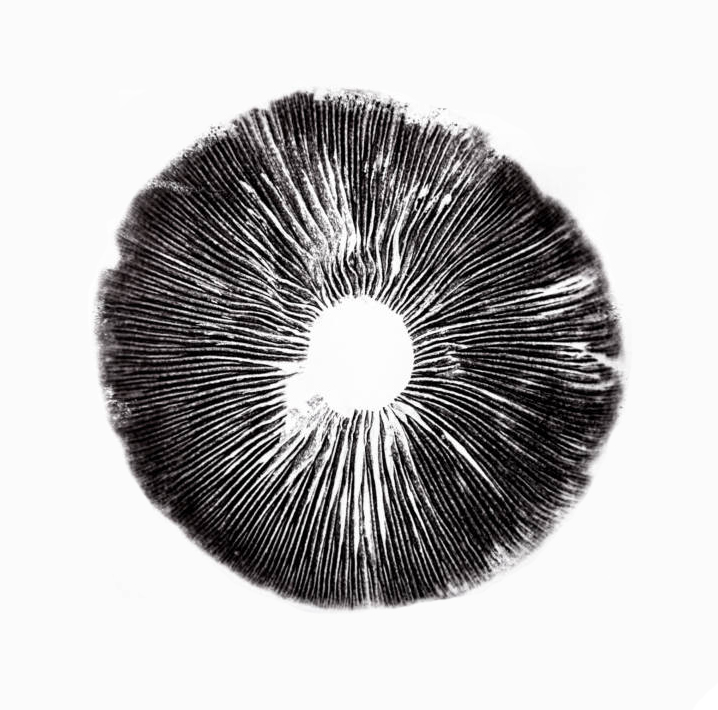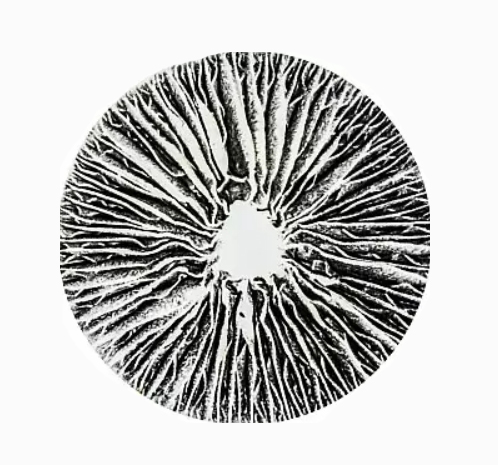Spores of Psilocybin Mushrooms
In this category, we present samples of the most popular strains of magic mushrooms, proven by time and a wide audience of enthusiasts. In our collection you will find strains with the most diverse characteristics, capable of satisfying the needs and wishes of both complete beginners and experts familiar with the most advanced cultivation techniques. When buying spore prints in the KADAMA shop, you can be sure as we guarantee that the material you have chosen has been obtained according to the latest technological requirements, and each sample carries a part of our producers' enthusiasm and devotion to their craft.
What is a Spore Print?

The starting point of the mushroom growing is the acquisition of a spore print. Do not be confused with its simple form, which is a circle of black, gray, or brown color with a diameter of a few centimeters. If you examine it under a microscope, you will see millions of spores. It is these spores that carry the genetic information of the strain which the mushroom that left this print belongs to. In practice, only up to 5% of these spores will produce offspring, more than enough to complete an entire growing cycle and provide an excellent yield. To produce a high-quality print, responsible producers use mushrooms with large, fully open caps, placing them in strictly sterile, high humidity conditions to initiate the spore release process.
How to choose a strain for cultivation? There is no clear division of mushrooms for beginners and professionals, so almost any strain can be grown by mycologists of different skill levels. However, this does not mean that all mushrooms are suitable for the same growing conditions or have the same properties. Magic mushrooms differ in factors such as resistance to pathogens, tolerance to temperature fluctuations, rate of the substrate's colonization, and sensitivity to its composition. Their combination makes up the distinction that is worth paying attention to, especially if you are just embarking on your cultivation journey. However, a beginner can be successful with even the most demanding strain by strictly adhering to all the recommendations, which are sometimes not so easy to follow. Carefully read our article "How to Choose Magic Mushrooms for Cultivation" to understand the basic principles to observe in this responsible endeavor. You can also study the characteristics presented in the strain description on its page in the KADAMA shop to apply these principles in practice and choose a variety of magic mushrooms that will not only bring you a solid harvest, but also inspire you to further steps and experiments in the noble pursuit of mushroom growing.
Basic Rules and Stages of Cultivation
The cornerstone of mushroom cultivation is keeping sterile conditions. This means routine disinfection of work surfaces and tools with alcohol or antiseptic, the use of a medical mask and gloves, and careful preparation and processing of the substrate. Failure to follow this simple rule may result in the risk of contamination of the substrate block and, consequently, a reduction or loss of the harvest.
Maintain the optimal microclimate that corresponds to a particular stage of mycelial development. During colonization, when the mycelium is just adapting to the provided nutrient substrate (mostly grain cultures), it needs a warm, dry, and dark environment to fully mimic the conditions in which it develops in nature. Maintain a stable temperature within 25-30 °C (depending on the species and strains of mushrooms, this indicator may vary). Relative humidity – 30-45%.
During the fruiting stage (to recreate the rainy season), when the mycelium produces fruiting bodies under natural conditions, substrate blocks are placed in the fruiting chamber. The optimum temperature for Psilocybe cubensis is 21-25 °C, and even at this stage, mushrooms of the Panaeolus species prefer 27-30 °C. As for humidity, the hygrometer readings should not fall below 90%. Ensure the supply of fresh air and install a faint light source for the directed growth of the fruiting bodies.

How to Use Magic Mushrooms?
Traditionally, magic mushrooms are taken on an empty stomach in dried or raw form, but there are other methods, such as making mushroom tea. Some users meditate before the trip to clear the mind and set the stage for a complete, deep connection with the cosmos. Whether you plan to travel alone or with company, in the woods or at home, sitting or moving, a positive attitude, a comfortable and friendly atmosphere are critical aspects of an enjoyable journey.
For your first encounter with mushrooms, be sure to invite an experienced sitter (guide) who can steer your thoughts in the right direction and lay a solid foundation for this aspect of your life.
Another essential part of a successful trip is preparation. This includes minimizing or excluding animal products, alcohol, and psychoactive substances, including caffeinated beverages, from your diet at least one day (preferably three) before the session. If possible, reduce social activities and limit your access to negative, irritating, or disturbing content.
Dosages and Effects
Please note! Amounts less than 0.5g are not considered in this article as they fall into the realm of microdosing which, due to its specificity, has its own set of guidelines and consumption characteristics.
Dosages are individual for each user. Body type, sensitivity to the active substances in the mushrooms, desired effects and attitude, as well as the psilocybin and psilocin content of individual fruiting bodies; each of these factors determines the "working" dosage, which can vary from 0.5 to several grams of dried mushrooms. For a first trip, a recommended dosage is 1-1.5 g, allowing you to stay in a relatively manageable state and track the body's individual responses. More experienced users, seeking the full psychedelic effect, consume from 2 to 5 g. Dosages above 5 g are related to a loss of sense of space, time, and reality, as well as a "loss of ego", which can only be achieved by advanced travelers with extraordinary self-control and extensive experience with mushrooms. The above dosages apply to mushrooms of the genus Psilocybe cubensis. For other magic mushrooms, such as Panaeolus and other species of Psilocybe, the recommended amount to consume may vary.
The first effects of magic mushrooms are felt within 25-60 minutes after ingestion. With their onset, you may experience nausea, slight dizziness, chills, yawning, and increased salivation. This is the body's normal response to the so-called "come-up syndrome", which signals the proximity of the peak. After 1-1.5 hours, you will feel that all your senses become incredibly sharpened, and your perception of the world, the universe, and even yourself will change, becoming clearer and more vivid. Answers to questions that have haunted you for years will unfold before you. All objects around you will blur their contours and appear to be moving in a harmonious dance; the hidden will be revealed, and you will merge with space, becoming one seamless whole. When you close your eyes, you will see a kaleidoscope of intricate, colorful patterns, sometimes taking the shape of conscious beings. This phase lasts for 3-4 hours, and then the psychedelic effect will gradually fade in a wave-like manner. However, even after the trip is over, you may observe a faint shimmer or movement, and a state of inner peace and purity may accompany you for several days.
Legality of the Spore Prints
Spore prints, like spore suspensions, do not contain psychoactive substances, so their purchase and storage are not prosecuted. Prohibited substances include mycelium in any form and the fruit bodies themselves, as they contain psilocybin and psilocin in their chemical composition. We recommend that you familiarize yourself with the current legislation in your country before deciding to grow magic mushrooms.
KADAMA welcomes the purchase of spore prints for scientific research purposes only. Our mission is to preserve the species and varietal diversity of the magical kingdom of mushrooms, and to inspire mycologists to microscopic research and experimentation for the benefit of mankind and nature.
![[``]](/wa-data/public/site/themes/kadama/img/kadama_logo.svg)





